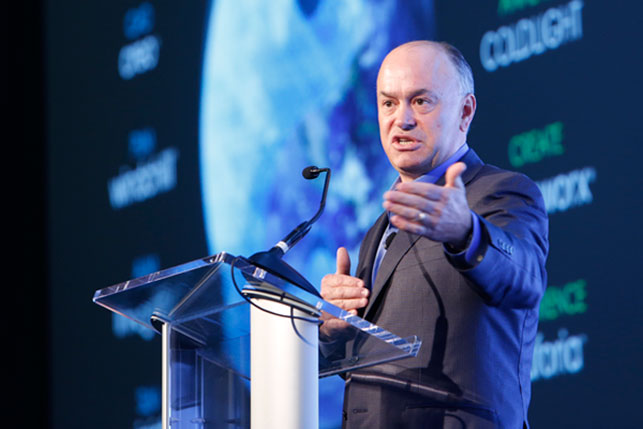It might sound like a simple rebranding exercise, but PTC’s new logo tells a good story about how the company is expanding its remit from its traditional market to a new, wider, focus.

PTC Chairman and CEO, Jim Heppelmann delivered a customer rich update on where PTC is heading
With investment over the last couple of years to the tune of half a billion dollars in all sorts of areas, a clear picture is now emerging of where the company sees its future. That future is within the Internet of Things (IoT) and Augmented Reality space. This became clear during the company’s demonstrations and customer presentations over the course of its annual LiveWorx event, which was held during June in Boston.
The new logo is intended to show a P intertwined with a D, representing the Physical and the Digital worlds. It’s also styled to represent the ThingMarks that are core to making its Augmented Reality work. As such it’s a bold statement.
But perhaps the biggest news out of its LiveWorx event was the launch of the snappily named Vuforia Studio Enterprise. This is a new application stack that combines some of PTC’s existing tools with a brand new cloud-based infrastructure for developing augmented reality assets.
Vuforia Studio Enterprise
To break it down further, the solution covers the whole process of taking heavy CAD data (in terms of data size and complexity), pre-processing it to make it more lightweight (so it’s suitable for efficient mobile deployment), constructing the augmented reality experiences as well as the process of preparing further assets in terms of assembly, disassembly and service instructions.
At the event we got some time with the team behind the product and I have to say, it’s impressive. It begins with the ThingMark. This is a bar-code like device that links the consumer of the data to the appropriate assets, whether that’s a single instance or a product family. You create this ViewMark in Vuforia Studio Enterprise, then start to import your CAD geometry.
Here, PTC has done a lot of work, based on its ProductView platform, to take heavy CAD geometry and strip it back to just the elements you need. As an example, the demonstration was centred on a 500Mb Creo model which was reduced down to less than 10Mb (a lighter weight, more tesselated version cut that down to 1.2Mb). This is arranged in the workspace, the ViewMark positioned and then processed.
Now, to see how this works, the same ThingMark, in terms of position and size, was replicated on the actual product. Once it was processed (this is done using the cloud), you fired up the Vuforia app, pointed it at the physical product’s ViewMark and, hey presto, you had a full 3D model available, that’s tracked and mapped to the physical item. There are also tools available to take data and analytics from PTC’s ThingWorx IoT platform and feed that into the same environment.
The product pilot program is bundling this with the full set of tools you need. That’s the cloud-based Vuforia Studio Enterprise for creating the assets, seats of Creo Illustrate (which is used to create assembly instructions and such), all of the server requirements as well as 100 unique ThingMarks.
Interestingly, PTC, once the pilot program is done, is considering a pay per use model for these tools. Perhaps this is key, as organisations will be looking for an ROI case for the work that’ll be needed to get benefit from Augmented Reality and with this business model, they’ll be charged when the assets are used and deployed in the field.

Terri Lewis, digital & technology director at Caterpillar Inc showed how she sees Augmented Reality’s impact on field service equipment maintenance and repair
Conclusion
PTC’s vision has expanded massively in the last few years and it has been interesting to watch it evolve. CEO, Jim Heppelmann, clearly has a mastery of taking a set of ideas and fleshing out a strategy around them. The company has also backed that vision with some serious spending in recent years, in the IoT space as well as Augmented Reality.
What is also clear is that the company is building a set of solutions that look at taking the often seemingly complex process of first connecting a device to the internet, then gaining value from it.
Ultimately, the success of that vision will come down to customer adoption. Judging by the customer presentations and conversations we had while at the event, that interest is growing and the set of tools that PTC is currently building looks to make the most of its traditional focus on both Product Lifecycle Management and 3D focussed design and documentation and adapting that knowledge to make further use of it.
ptc.com
Creo 4.0: What’s the latest?
Of course, while PTC’s event largely focussed on the future of the company, it is also a gathering of users of its existing toolsets and the one that most of our readers will be interested in is Creo. While there were no announcements made about the Creo 4.0 release, we do know that it’s scheduled for launch later this year and it seems like there are some interesting looking tools coming.
Whether that’s lattice structure design (which is a big focus for quite a few vendors at the moment), or model based definition or 3D annotation, which should be interesting considering PTC’s activities in the use of 3D data downstream in manufacturing and product use life. And there’s even talk of new movement on the core of Creo and how users interact with model selection.
Al Dean reports from PTC’s LiveWorx event in Boston, USA
Default






